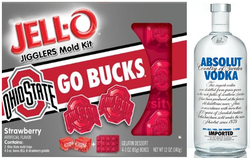 Thanks to the "TaxProf" Blog for this Pic.
Thanks to the "TaxProf" Blog for this Pic. With such a shift you would think that Jell-O may have noticed, and may have seized on the opportunity to correct a trend that promises to potentially take the Jell-O trademark into the abyss of genericide (I know, I use that term a lot, but the ominous nature of the topic deserves repeating). Instead, it looks like they are doubling down on a co-branding initiative with various universities across the U.S. to promote Jell-O molding kits that include university molds. As a well-known trademark attorney has remarked, there appears to be some double-speak about Jell-O’s true demographic here, or at least the real reason behind this initiative. After all, we know what most food items bearing university insignia (or any type of sports insignia) go hand-in-hand with one of America’s favorite pre-game past times: tailgating. And what does Jell-O and tailgating have in common? If you said most-creative mold making contests, you are wrong.
With such a dramatic change of brand perception, marketing your product to college students and dyed-in-the-wool alumni looking for a fun snack (at least that’s the ostensible market), there doesn’t appear to be much to lose. Or maybe Jell-O isn’t losing that much in pursuing co-branding opportunities where the demographic enjoys mixing libations with the jiggly gelatinous dessert. After all, one of Jell-O’s taglines appears to be “Every cup is a one-way ticket to Funtown.” If a consumer equates the Jell-O brand with fun and parties (which abounds wherever there are little cups filled with colorful gelatin with liquor), isn’t this a positive association? The fact that consumers of the product may see the brand used in a particular context that is less than moral doesn’t diminish the goodwill associated with the trademark. It may expand the sources from which that goodwill comes (many customer groups across different age brackets and interests is a good thing, after all), but as long as it doesn’t cloud the ability of a trademark to indicate a source and doesn’t dilute the strength of the brand, then expanding the reaches of the product isn’t a bad idea.
In this case Jell-O, by cutting co-branding deals with universities and (perhaps) professional sports teams, stands to align itself with the pastime of “Jell-O Shots”. If the shots that people are doing are really made from Jell-O, then there is no danger of genericide. And who knows? Maybe someday consumers will be so conscious of the Jell-O brand that the company can cease having to plaster “Brand” on the packaging as a means for telling consumers that Jell-O is in fact a trademark.
We’ll give them an A for the good-old college try. Only time will tell, however, if the Jell-O brand truly profits from this renewed effort to generate goodwill and put the jiggle back in Jell-O.


 RSS Feed
RSS Feed